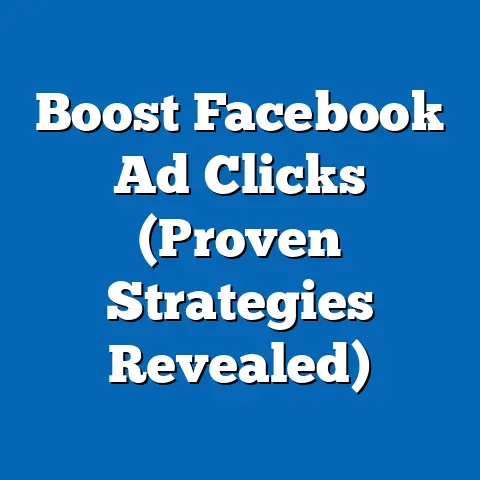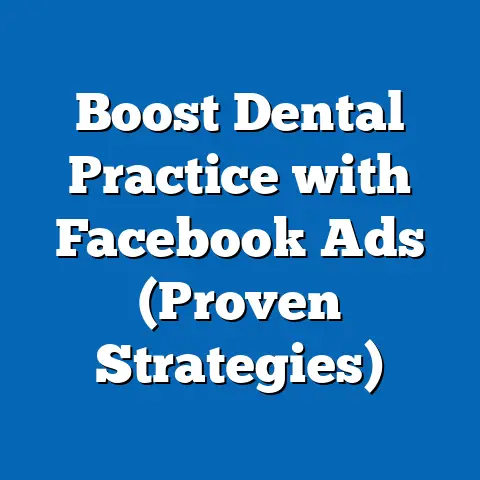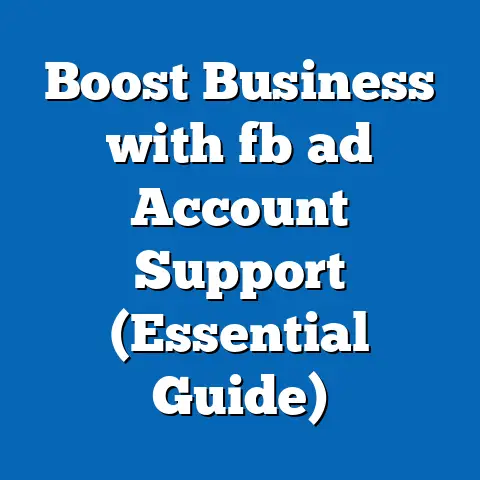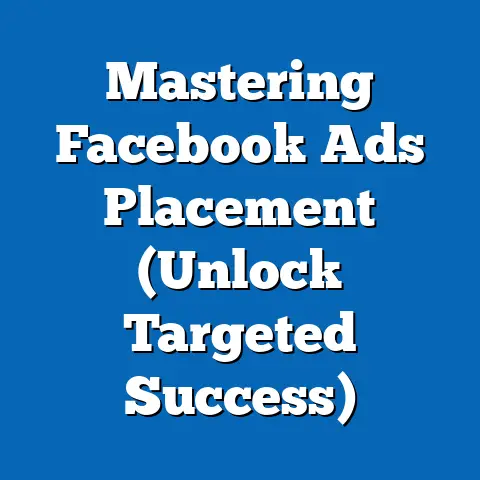Master Retargeting Facebook Ads (Proven Strategies Revealed)
Understanding Retargeting Ads
Retargeting, also known as remarketing, is a form of online advertising that allows you to show ads to people who have previously interacted with your website or mobile app. Think of it as a gentle reminder to those who showed initial interest but didn’t quite convert. It’s a second chance to grab their attention and guide them towards making a purchase or taking a desired action.
In the crowded digital landscape, where attention spans are shrinking faster than ever, retargeting is more crucial than ever. It cuts through the noise by focusing on individuals who have already expressed interest in your brand, making your advertising efforts far more efficient.
How it Works on Facebook:
Facebook retargeting primarily relies on two key technologies:
-
Facebook Pixel: This is a small snippet of code that you place on your website. When someone visits your site, the pixel drops a cookie, anonymously identifying them to Facebook. This allows you to track their actions, such as viewing specific pages, adding items to their cart, or completing a purchase.
-
Custom Audiences: Once the pixel is set up, you can create custom audiences based on the data it collects. These audiences are groups of people who have taken specific actions on your website, allowing you to target them with highly relevant ads.
Facebook Pixel: This is a small snippet of code that you place on your website. When someone visits your site, the pixel drops a cookie, anonymously identifying them to Facebook. This allows you to track their actions, such as viewing specific pages, adding items to their cart, or completing a purchase.
Custom Audiences: Once the pixel is set up, you can create custom audiences based on the data it collects. These audiences are groups of people who have taken specific actions on your website, allowing you to target them with highly relevant ads.
Retargeting vs. Traditional Advertising:
Traditional advertising often casts a wide net, targeting a broad audience in the hope of capturing a few interested individuals. Retargeting, on the other hand, is laser-focused. It targets individuals who have already shown interest in your brand, making your ads more relevant and effective. I like to think of it as the difference between shouting in a crowded stadium versus having a one-on-one conversation with someone who’s already interested in what you have to say.
Key Takeaway: Retargeting is a powerful advertising strategy that allows you to reconnect with potential customers who have already shown interest in your brand. Understanding the fundamentals of how it works is the first step towards mastering it.
Why Retargeting is Essential for Businesses
Let’s be honest, most people don’t buy something the first time they see it. They might browse, compare, and think about it before making a decision. Retargeting helps bridge that gap by keeping your brand top-of-mind and nudging potential customers towards conversion.
The Power of Numbers:
The numbers speak for themselves. Studies have shown that retargeting ads can increase website conversion rates by as much as 150%. Think about that for a second – more than doubling your conversions simply by reaching out to people who already know you!
Here’s a statistic I found particularly compelling: Website visitors who are retargeted with display ads are more likely to convert by 70%. That’s a massive increase in conversion probability!
I’ve personally seen these results in my own campaigns. One client, an e-commerce store selling handmade jewelry, saw a 60% increase in sales after implementing a well-structured retargeting campaign. It was a clear demonstration of the power of reaching the right people with the right message at the right time.
ROI and Conversion Rates:
Compared to regular ads, retargeting ads typically have a significantly higher ROI and conversion rate. This is because you’re targeting a warm audience, people who are already familiar with your brand and products. They’re further down the sales funnel and more likely to convert.
Nurturing the Buyer’s Journey:
Retargeting isn’t just about making a quick sale. It’s about nurturing potential customers through the buyer’s journey. By showing them relevant ads at different stages of their journey, you can guide them from awareness to consideration to decision.
For example, someone who visited your website but didn’t add anything to their cart might see ads showcasing your brand and its values. Someone who added items to their cart but didn’t complete the purchase might see ads featuring those specific items with a special discount.
Key Takeaway: Retargeting is a crucial component of any successful digital marketing strategy. It offers a higher ROI, better conversion rates, and the ability to nurture potential customers through the buyer’s journey.
Proven Strategies for Mastering Retargeting Ads
Now, let’s dive into the nitty-gritty of mastering retargeting Facebook Ads. These are the strategies I’ve personally used and seen success with, and I’m confident they can help you too.
1. Segmenting Your Audience:
One of the biggest mistakes I see marketers make is treating all website visitors the same. Not everyone is at the same stage of the buyer’s journey, and showing them the same ads is a recipe for disaster.
Segmentation is key to creating highly relevant and effective retargeting campaigns. By dividing your audience into smaller, more specific groups based on their behavior, you can tailor your ads to their individual needs and interests.
Here are a few examples of segments you can create:
-
Website Visitors: This is the broadest segment, including anyone who has visited your website. You can further segment this group based on the specific pages they visited. For example, you might create a segment for people who visited your product pages but didn’t add anything to their cart.
-
Cart Abandoners: These are people who added items to their cart but didn’t complete the purchase. This is a highly valuable segment, as they were clearly interested in your products.
-
Past Purchasers: These are your existing customers. You can target them with ads promoting new products or special offers to encourage repeat purchases.
-
Video Viewers: If you’re using video in your marketing strategy, you can create a segment of people who watched a certain percentage of your videos. This indicates a high level of engagement and interest.
Website Visitors: This is the broadest segment, including anyone who has visited your website. You can further segment this group based on the specific pages they visited. For example, you might create a segment for people who visited your product pages but didn’t add anything to their cart.
Cart Abandoners: These are people who added items to their cart but didn’t complete the purchase. This is a highly valuable segment, as they were clearly interested in your products.
Past Purchasers: These are your existing customers. You can target them with ads promoting new products or special offers to encourage repeat purchases.
Video Viewers: If you’re using video in your marketing strategy, you can create a segment of people who watched a certain percentage of your videos. This indicates a high level of engagement and interest.
2. Dynamic Product Ads:
Dynamic product ads (DPAs) are a game-changer for e-commerce businesses. They automatically show people ads for products they viewed on your website or in your app. This is a highly personalized and effective way to remind them of what they were interested in.
Setting up DPAs can seem daunting at first, but it’s worth the effort. You’ll need to upload your product catalog to Facebook and create a dynamic ad template. Facebook will then automatically populate the template with the products that each individual user viewed.
Tips for Setting Up Dynamic Ads Effectively:
-
Use high-quality product images: Your images are the first thing people will see, so make sure they’re visually appealing and accurately represent your products.
-
Write compelling ad copy: Highlight the key benefits of your products and include a clear call to action.
-
Use a variety of ad formats: Experiment with different ad formats, such as single image ads, carousel ads, and collection ads, to see what works best.
Use high-quality product images: Your images are the first thing people will see, so make sure they’re visually appealing and accurately represent your products.
Write compelling ad copy: Highlight the key benefits of your products and include a clear call to action.
Use a variety of ad formats: Experiment with different ad formats, such as single image ads, carousel ads, and collection ads, to see what works best.
3. Crafting Compelling Ad Copy and Creative:
Your ad copy and creative are what will ultimately grab people’s attention and convince them to click. It’s essential to tailor your messaging to each specific segment.
For example, if you’re targeting cart abandoners, your ad copy might emphasize the benefits of completing their purchase, such as free shipping or a limited-time discount. If you’re targeting past purchasers, your ad copy might highlight new products or special offers.
The Role of Visuals:
Visuals are just as important as your ad copy. Use high-quality images or videos that are relevant to your target audience and showcase your products in the best possible light.
4. Timing and Frequency:
The timing and frequency of your retargeting ads are crucial. You don’t want to bombard people with too many ads, but you also don’t want to let them forget about you.
Ad Frequency:
Ad frequency refers to the number of times a person sees your ad. It’s important to find the right balance. Too few ads, and people might not remember you. Too many ads, and you risk annoying them and causing ad fatigue.
Optimal Timing:
The optimal timing for your retargeting ads will depend on your target audience and your products. Experiment with different schedules to see what works best.
Avoiding Ad Fatigue:
Ad fatigue is a real problem. When people see the same ads over and over again, they start to tune them out. To avoid ad fatigue, it’s important to:
-
Rotate your ads regularly: Create new ads with different images, videos, and ad copy.
-
Use frequency capping: This allows you to limit the number of times a person sees your ad in a given period.
-
Refine your targeting: Make sure you’re only targeting people who are truly interested in your products.
Rotate your ads regularly: Create new ads with different images, videos, and ad copy.
Use frequency capping: This allows you to limit the number of times a person sees your ad in a given period.
Refine your targeting: Make sure you’re only targeting people who are truly interested in your products.
5. Utilizing Custom Audiences:
Custom Audiences are the backbone of any successful retargeting campaign. They allow you to target specific groups of people based on their behavior.
I mentioned them briefly earlier, but it’s worth reiterating how powerful they are. You can create Custom Audiences based on:
-
Website traffic: Target people who visited specific pages on your website.
-
Customer lists: Upload a list of your existing customers and target them with ads.
-
App activity: Target people who have taken specific actions in your app.
-
Engagement on Facebook: Target people who have interacted with your Facebook page or ads.
Website traffic: Target people who visited specific pages on your website.
Customer lists: Upload a list of your existing customers and target them with ads.
App activity: Target people who have taken specific actions in your app.
Engagement on Facebook: Target people who have interacted with your Facebook page or ads.
Lookalike Audiences:
Once you’ve created Custom Audiences, you can use them to create Lookalike Audiences. These are audiences of people who are similar to your existing customers or website visitors. This is a great way to expand your reach and find new potential customers.
6. A/B Testing and Optimization:
No retargeting campaign is perfect from the start. It’s essential to continuously test different ad variations and optimize your campaigns based on data.
A/B Testing:
A/B testing involves creating two versions of an ad with one key difference, such as the headline, image, or call to action. You then show both versions to a portion of your audience and see which one performs better.
Optimization:
Once you’ve collected enough data, you can start to optimize your campaigns. This might involve:
-
Adjusting your targeting: Refine your targeting to focus on the people who are most likely to convert.
-
Changing your ad copy or creative: Experiment with different messaging and visuals to see what resonates best with your audience.
-
Adjusting your bidding strategy: Experiment with different bidding strategies to see what gives you the best ROI.
Adjusting your targeting: Refine your targeting to focus on the people who are most likely to convert.
Changing your ad copy or creative: Experiment with different messaging and visuals to see what resonates best with your audience.
Adjusting your bidding strategy: Experiment with different bidding strategies to see what gives you the best ROI.
Key Takeaway: Mastering retargeting Facebook Ads requires a strategic approach, including audience segmentation, dynamic product ads, compelling ad copy and creative, optimal timing and frequency, effective use of Custom Audiences, and continuous A/B testing and optimization.
Common Mistakes to Avoid
Even with the best strategies, it’s easy to make mistakes when running retargeting campaigns. Here are a few common pitfalls to avoid:
-
Not segmenting your audience: As I mentioned earlier, treating all website visitors the same is a recipe for disaster.
-
Showing the same ads too often: This can lead to ad fatigue and annoy your audience.
-
Not using frequency capping: This allows you to limit the number of times a person sees your ad.
-
Not testing your ads: You should always be testing different ad variations to see what works best.
-
Not monitoring your results: You need to track your key metrics, such as conversion rate and ROI, to see how your campaigns are performing.
Not segmenting your audience: As I mentioned earlier, treating all website visitors the same is a recipe for disaster.
Showing the same ads too often: This can lead to ad fatigue and annoy your audience.
Not using frequency capping: This allows you to limit the number of times a person sees your ad.
Not testing your ads: You should always be testing different ad variations to see what works best.
Not monitoring your results: You need to track your key metrics, such as conversion rate and ROI, to see how your campaigns are performing.
Key Takeaway: Avoiding these common mistakes can significantly improve the performance of your retargeting campaigns.
Future Trends in Retargeting
The world of digital advertising is constantly evolving, and retargeting is no exception. Here are a few emerging trends to watch out for:
-
AI and Machine Learning: AI and machine learning are already being used to optimize retargeting campaigns, and this trend will only continue. AI can help you identify the best targeting options, create more personalized ads, and optimize your bidding strategy.
-
Cross-Device Retargeting: As people use more and more devices, it’s becoming increasingly important to target them across all of their devices. This requires sophisticated tracking and attribution techniques.
-
Privacy-Focused Retargeting: With increasing concerns about privacy, retargeting is becoming more privacy-focused. This means using more anonymized data and being more transparent about how you’re using data.
AI and Machine Learning: AI and machine learning are already being used to optimize retargeting campaigns, and this trend will only continue. AI can help you identify the best targeting options, create more personalized ads, and optimize your bidding strategy.
Cross-Device Retargeting: As people use more and more devices, it’s becoming increasingly important to target them across all of their devices. This requires sophisticated tracking and attribution techniques.
Privacy-Focused Retargeting: With increasing concerns about privacy, retargeting is becoming more privacy-focused. This means using more anonymized data and being more transparent about how you’re using data.
Key Takeaway: Staying ahead of the curve and embracing these emerging trends will be crucial for success in the future of retargeting.
Conclusion
Mastering retargeting Facebook Ads is essential for any business looking to boost their advertising ROI. By segmenting your audience, using dynamic product ads, crafting compelling ad copy and creative, optimizing timing and frequency, utilizing Custom Audiences, and continuously A/B testing and optimizing your campaigns, you can turn those casual browsers into loyal customers.
Don’t be afraid to experiment and try new things. The key is to continuously learn and adapt to the ever-changing landscape of digital advertising. Implement the strategies I’ve discussed, monitor your performance over time, and watch your conversions soar! Effective retargeting can significantly enhance your advertising efforts and drive the growth of your business. Now go out there and start retargeting like a pro!






